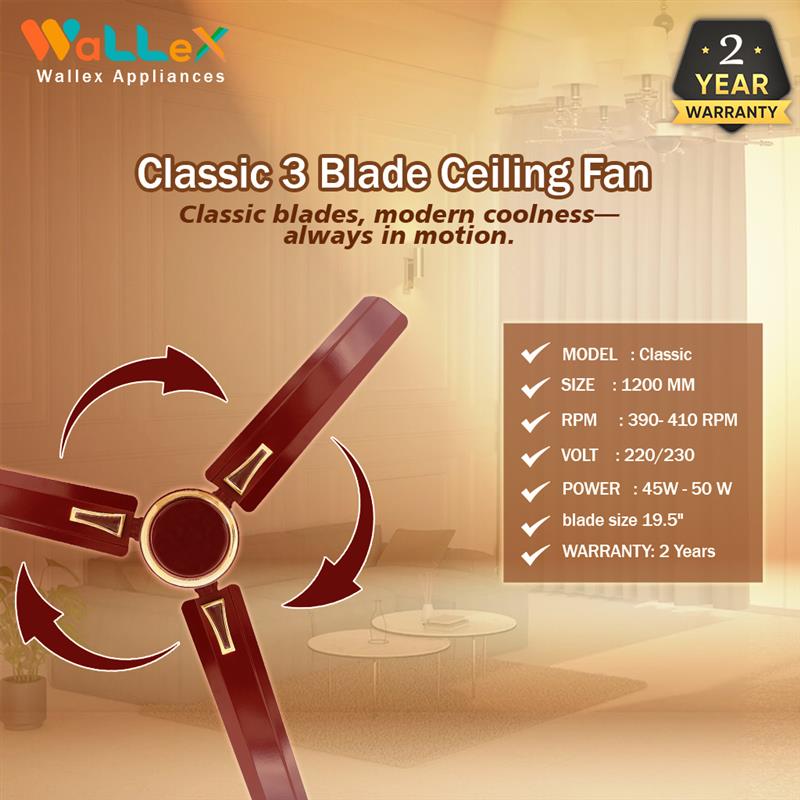Ceiling fans have long been an essential fixture in homes, offices, and commercial spaces. They provide an energy-efficient way to circulate air, reduce reliance on air conditioning, and enhance interior aesthetics. Over the years, ceiling fans have evolved significantly, with numerous styles, features, and technologies now available to suit diverse needs. Choosing the right type of ceiling fan depends on factors such as room size, ceiling height, climate, décor style, and budget.
This article explores the type of ceiling fans and their features to help you make an informed choice.
1. Standard Ceiling Fans
Standard ceiling fans are the most common and versatile type, designed for rooms with ceilings that are 8 feet or higher. They typically feature 4 to 5 blades, a built-in motor housing, and come in a variety of finishes such as wood, metal, or plastic.
Many standard fans include a downrod, which helps maintain proper distance from the ceiling to ensure optimal air circulation. These fans often support light kits, making them a dual-purpose fixture for both cooling and illumination.
They are ideal for bedrooms, living rooms, and dining areas, where traditional aesthetics and functional cooling are equally important.
2. Low-Profile or Hugger Ceiling Fans
Low-profile fans, also known as flush-mount or hugger fans, are specifically designed for rooms with low ceilings (below 8 feet). Instead of using a downrod, these fans are mounted directly to the ceiling.
Because of their close placement to the ceiling, hugger fans provide slightly less airflow compared to standard fans, but they are the safest and most practical option for compact spaces.
They come in various designs, from contemporary to rustic, and are ideal for apartments, small bedrooms, and attics where ceiling clearance is limited.
3. Dual-Motor Ceiling Fans
Dual-motor ceiling fans, also known as twin ceiling fans, feature two adjustable fan heads mounted on either side of a central motor housing. Each fan head can be angled independently, allowing for customized airflow direction.
These fans not only provide powerful circulation but also serve as a statement piece due to their unique design.
They are perfect for large rooms, open-concept spaces, or commercial areas, as they can efficiently move air across a wide area while adding a touch of sophistication.
4. Energy-Efficient Ceiling Fans
With the growing focus on sustainability, energy-efficient ceiling fans have gained popularity. These fans use advanced motor technologies such as DC (direct current) motors, which consume up to 70% less energy compared to conventional AC motors.
Many models come with the ENERGY STAR certification, ensuring they meet strict energy efficiency guidelines.
Energy-efficient fans often include features like variable speed settings, remote control, and reversible motor functions, making them suitable for eco-conscious households and commercial buildings.
5. Remote-Controlled Ceiling Fans
Modern ceiling fans increasingly come with remote control capabilities, allowing users to adjust speed, lighting, and rotation direction without manual operation.
These fans are particularly useful for large rooms, high-ceilinged spaces, or bedrooms, where accessing wall switches or pull chains might be inconvenient.
Some models also integrate with smart home systems, enabling voice or app-based control, making them an excellent choice for tech-savvy homeowners.
6. Outdoor and Damp-Rated Ceiling Fans
Outdoor ceiling fans are specially designed to withstand humidity, moisture, and varying weather conditions. These fans are classified as either damp-rated or wet-rated.
-
Damp-rated fans are suitable for covered outdoor areas, such as patios, porches, and sunrooms.
-
Wet-rated fans can withstand direct exposure to rain and snow, making them ideal for gazebos, pergolas, and open decks.
They are constructed from rust-resistant materials and often have sealed motor housings to prevent water damage.
7. Industrial Ceiling Fans
Industrial ceiling fans are large, heavy-duty fans designed for warehouses, factories, gyms, and other commercial settings.
They feature powerful motors, longer blades, and wider blade spans, allowing them to move a high volume of air across large spaces.
While primarily functional, some modern industrial fans are designed with sleek finishes, making them suitable for loft apartments or contemporary interiors where a bold statement piece is desired.
8. Smart Ceiling Fans
Smart ceiling fans are an advanced variant that can connect to Wi-Fi and integrate with smart home ecosystems such as Alexa, Google Assistant, or Apple HomeKit.
These fans allow users to control speed, lighting, and timers via smartphones, tablets, or voice commands.
They often include energy-monitoring features, programmable schedules, and adaptive cooling modes, making them ideal for modern, connected homes.
9. Retractable Blade Ceiling Fans
Retractable blade fans are a fusion of chandeliers and ceiling fans. The blades remain hidden when the fan is not in use, and extend out when it is turned on.
This design offers a luxurious and space-saving solution, making them perfect for living rooms, dining areas, and upscale interiors where style is as important as functionality.
They are available in a variety of chandelier styles, from crystal and glass to modern LED fixtures.
10. Bladeless Ceiling Fans
Bladeless ceiling fans, also called air multipliers, use innovative technology to circulate air without visible blades.
They are safer for households with children and pets and provide quiet, efficient airflow.
Although less common and more expensive, bladeless fans are an attractive choice for contemporary homes where minimalistic design is preferred.
11. Ceiling Fans with Lights
Ceiling fans with integrated light kits serve a dual purpose of cooling and illumination.
They are available in various styles—modern, rustic, industrial, or traditional—and can include LED, halogen, or CFL bulbs.
Many models allow users to dim or change light color temperatures, making them suitable for multi-functional spaces like bedrooms and living rooms.
12. Outdoor Ceiling Fans with Heaters
Some high-end outdoor ceiling fans include built-in heaters, making them perfect for patios, decks, or outdoor dining areas in colder regions.
These fans provide air circulation during summer and radiant heat during cooler months, ensuring year-round usability.
13. Energy Recovery Ceiling Fans
Energy recovery fans are equipped with special motors and reversible blades that can switch airflow direction.
-
Counterclockwise rotation provides a cooling breeze during summer.
-
Clockwise rotation circulates warm air during winter, reducing heating costs.
This makes them highly versatile and cost-effective for all seasons.
14. Designer and Decorative Ceiling Fans
Designer ceiling fans emphasize aesthetic appeal while providing functionality.
These fans are available in custom finishes, unique blade shapes, and artistic designs, making them suitable for luxury interiors, hotels, or upscale restaurants.
They often blend modern technology with creative artistry, serving as functional décor pieces.
15. Portable Ceiling Fans
Portable ceiling fans are a relatively new concept that can be mounted temporarily or moved easily.
They are powered by battery or plug-in options, making them convenient for outdoor events, camping, or temporary setups where permanent installations are not feasible.
How to Choose the Right Ceiling Fan
When selecting a ceiling fan, consider:
-
Room Size & Blade Span – Larger rooms require fans with longer blade spans (52 inches or more).
-
Ceiling Height – Low-profile fans are ideal for low ceilings, while high ceilings benefit from downrod fans.
-
Airflow & Energy Efficiency – Look for models with higher CFM (cubic feet per minute) ratings and DC motors for better efficiency.
-
Indoor vs. Outdoor Rating – Ensure outdoor fans are damp or wet-rated for safety.
-
Style & Features – Choose a fan that matches your décor and offers features like lights, remote control, or smart connectivity.
Conclusion
Ceiling fans are no longer just basic cooling appliances—they have transformed into multi-functional, energy-efficient, and aesthetically pleasing fixtures. From standard models to advanced smart fans, there is a perfect ceiling fan for every space and style.
By understanding the different types of ceiling fans, you can select one that enhances comfort, saves energy, and complements your interior design.






